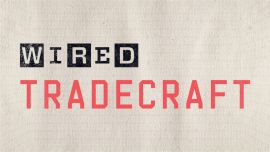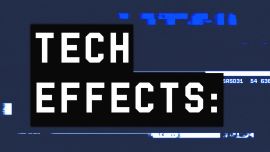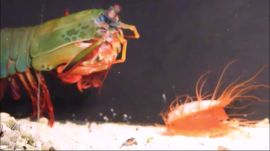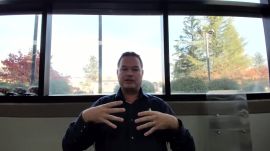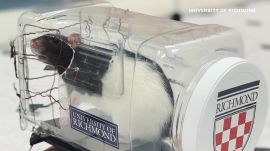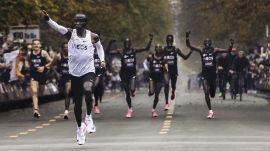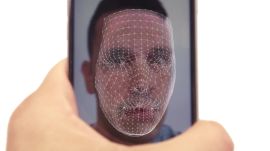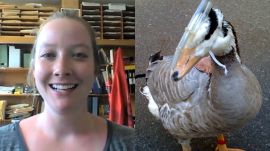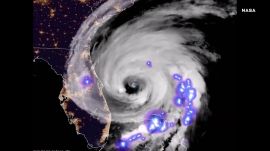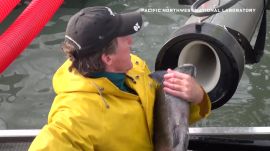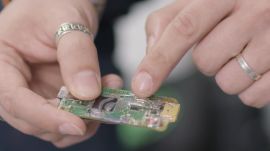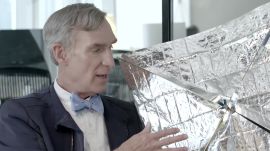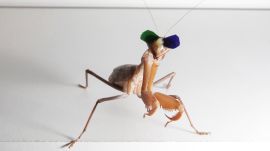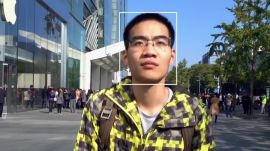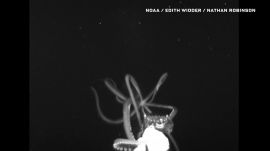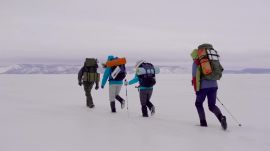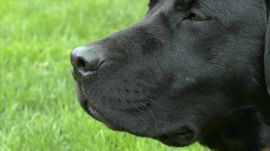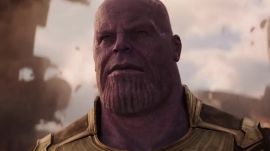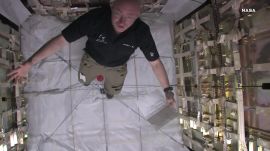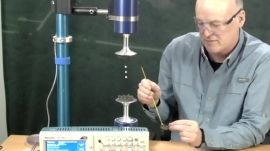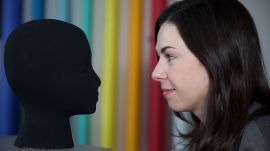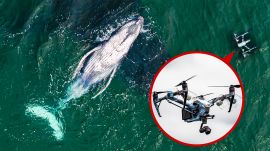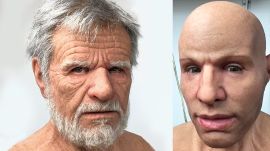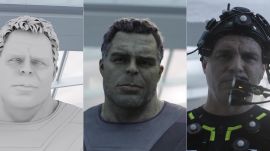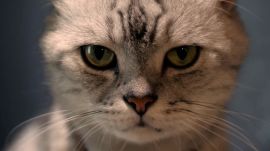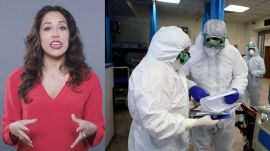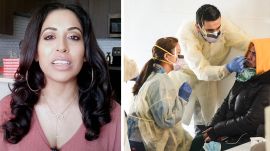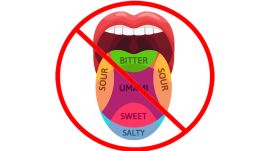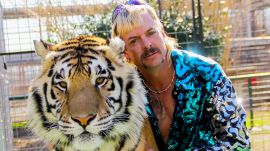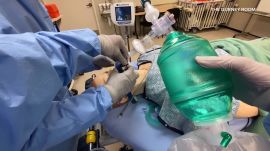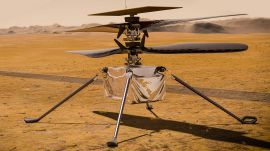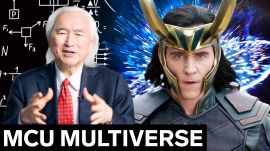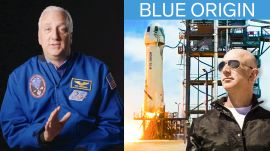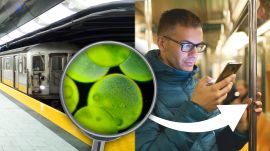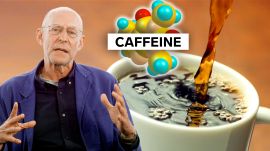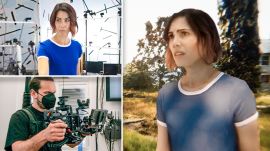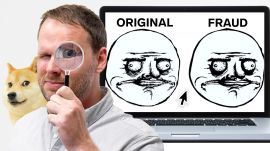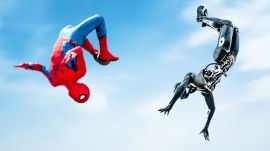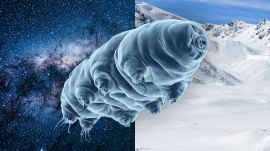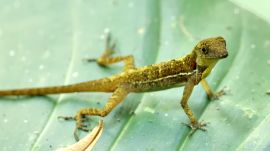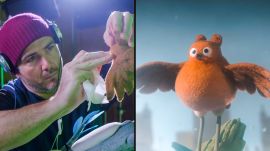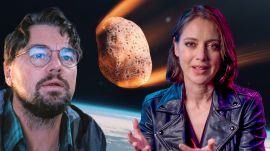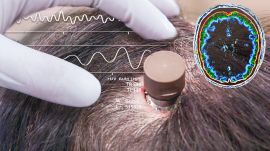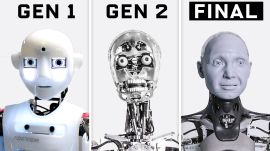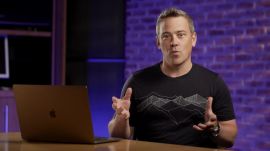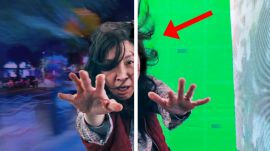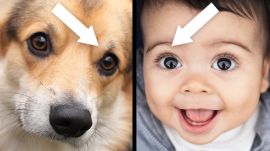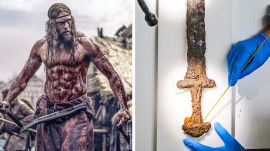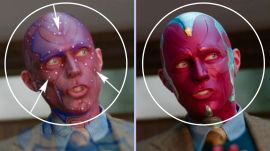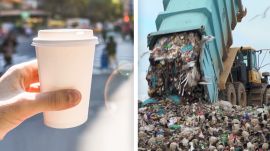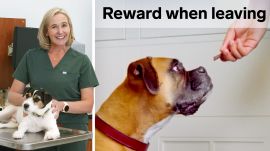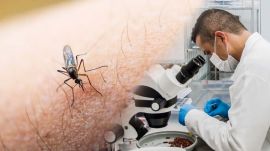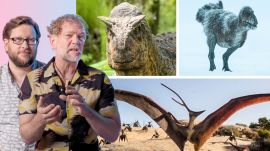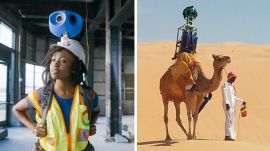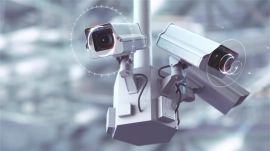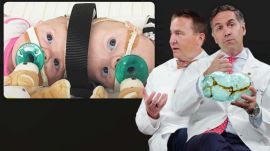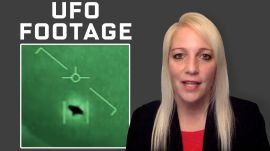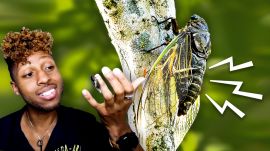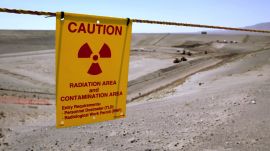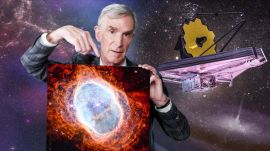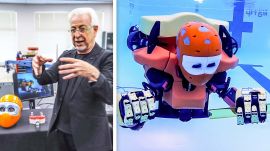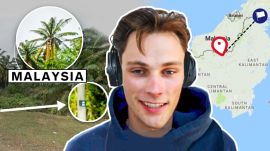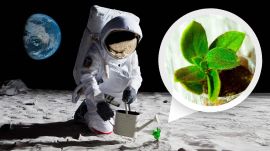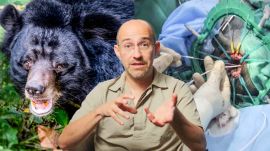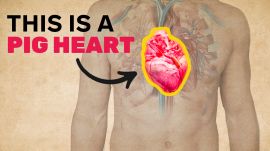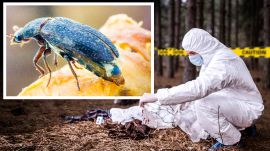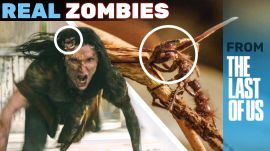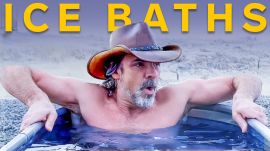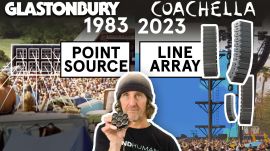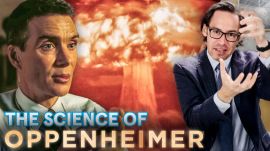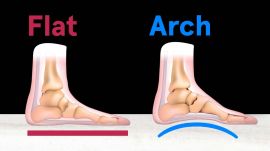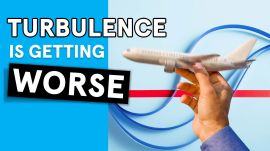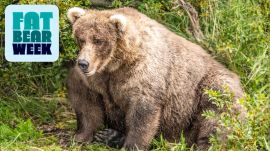Currents
1 season, 133 episodesAll the latest news in the world of science and technology.
Season 1
Science
When the disco clam, a bivalve with a flashing light display, is faced with the predatory power of the punching mantis shrimp, things get interesting. Marine biologist Lindsey Dougherty explains the bizarre behavior she’s been observing in her lab. CORRECTION: 3:31-3:41 the animals shown when Dr. Dougherty was talking about bioluminescence were not exhibiting the characteristic. WIRED regrets the error.Design
To live on Mars humans may have to rely on robotically 3D printed homes like the structures designed by AI SpaceFactory. WIRED's Arielle Pardes talks with AI SpaceFactory CEO and architect David Mallot about how this new technology works and could be used here on Earth as well.Science
Researcher Ying-Hui Fu has found two rare genes that allow some people to be "natural short sleepers" who feel rested after a mere 4 or 5 hours per night. WIRED's Arielle Pardes sat down with Dr. Fu to discuss her findings.Science
This piece of metal is unsinkable. WIRED's Matt Simon spoke with the inventor, Chunlei Guo, about how the superhydrophobic material was created and how it could help prevent disasters at sea.Science
Videos of a new product being called an invisibility cloak recently surfaced online. WIRED's Louise Matsakis spoke with its inventor and a physicist who studies optics to find out how it works and whether cloaking and invisibility are truly feasible.Science
There's the rat race, and then there are these lab rats who learned to drive tiny cars. WIRED's Matt Simon talked with neuroscientist Kelly Lambert about what her driving rodent experiment can teach us about neuroplasticity and learning new skills.Science
Physarum polycephalum is a single-celled, brainless organism that can make “decisions,” and solve mazes. Anne Pringle, who is a mycologist at the University of Wisconsin-Madison, explains everything you need to know about what these slime molds are and how they fit into our ecosystem.Science
On Saturday, October 12, 2019, Eliud Kipchoge became the first person ever to run a marathon in under two hours, a staggering achievement in athletics and human performance. Dr. Michael Joyner, an exercise physiologist at the Mayo Clinic, first predicted it might be possible in a paper he wrote in 1991. WIRED's Robbie Gonzalez has been following Kipchoge's attempts for years, and spoke with Joyner about how Kipchoge finally made it happen.Science
Cats are famously temperamental and are generally considered to be less loyal and social than dogs. But recent research suggests that cats actually have similar levels of attachment to their human caregivers as dogs and infants. WIRED's Arielle Pardes spoke with Kristyn Vitale from Oregon State University's Human-Animal Interaction Lab to find out more.Science
Sam Gregory, program director at the human rights nonprofit WITNESS, talks with WIRED senior writer Tom Simonite about the implications of Deepfake videos and how we can adjust to this new and improving technology.Science
Bar-headed geese are the SR-71's of the avian world, soaring to 26,000 feet. To learn how their bodies function so well at altitude researchers raised a gaggle of geese, introduced them to a wind tunnel, strapped tiny masks to their beaks and sensor packs on their backs.Science
NOAA meteorologist researcher Jason Dunion talks with WIRED reporter Matt Simon about what it's like to fly a plane into a hurricane, and how scientists track and predict storms.Science
Fisheries researcher Alison Colotelo talks with WIRED's Robbie Gonzalez about the viral fish tube, and why fish transportation isn't as easy as you might think.Science
Biohacker Michael Laufer recently had a 512GB drive implanted in his leg, which can store data, stream music or movies, and power a hot spot and mesh network. It's called the PegLeg, and WIRED's Daniel Oberhaus spoke with Laufer about the device and the field of biohacking.Science
Don Swanson, a scientist with the United States Geological Survey, explains why researchers are so interested in a pool of water that's formed in the crater of Hawaii's Kilauea volcano.Science
On June 25, the Planetary Society's LightSail 2 hitched a ride into orbit on board SpaceX's Falcon Heavy rocket. The solar sail is propelled only by sunlight, and its technology holds promise for early detection of major events in space, as well as travel across vast distances. To find out more, WIRED's Daniel Oberhaus spoke with Planetary Society CEO, Bill Nye.Science
Researchers at Newcastle University, UK have been studying stereoscopic vision in praying mantises by having them wear tiny 3D glasses. WIRED's Matt Simon talks with Jenny Read, a vision scientist who led the research, about how their vision compares with humans and what that means for machine vision.Business
A handful of US cities have banned government use of facial recognition technology due to concerns over its accuracy and privacy. WIRED's Tom Simonite talks with computer vision scientist and lawyer Gretchen Greene about the controversy surrounding the use of this technology.Science
A new interactive map from researchers at the University of Maryland shows how cities might be transformed by climate change. WIRED's Matt Simon talks with environmental scientist Matt Fitzpatrick about the map and why San Francisco could feel like Los Angeles by 2080.Science
WIRED speaks with Angel Abbud-Madrid, the Director of the Center for Space Resources at the Colorado School of Mines, to find out just how lunar mining would work.Science
Dr. Edith Widder and a team of scientists captured the first footage of a live giant squid in U.S. waters. WIRED's Matt Simon spoke with Widder to learn the story behind the video.Science
A recent F.D.A. study shows that certain chemicals in some sunscreens can seep into and remain in people's blood. To find out what that means for staying safe in the sun, WIRED's Robbie Gonzalez spoke with dermatologist Dr. Kanade Shinkai.Culture
The 1980's nostalgia and sci-fi show Stranger Things returns for season three with a new setting: The Starcourt Mall. WIRED's Emily Dreyfuss talks with architecture professor Ellen Dunham-Jones about mall culture and the fate of dead malls. Hint, zombies.Science
To find just how far the human body can be pushed researchers studied athletes who ran six marathons a week over months and compared their energy intake and expenditure data to those of other athletes, workers, and pregnant women. WIRED's Robbie Gonzalez talks with study author Herman Pontzer of Duke University about the findings.Science
A team from the University of Southern California's Rocket Propulsion Laboratory became the first student team to launch a rocket into space. WIRED's Arielle Pardes spoke with Neil Tewksbury, the team's Lead Operations Officer, about what it took to make it happen. Read more of the team's story on WIRED.com: https://www.wired.com/story/a-rocket-built-by-students-reached-space-for-the-first-time/Science
Dogs can smell explosives like landmines, and detect medical conditions including seizures, diabetes, and many forms of cancer -- with up to 98% accuracy. Inventor Andreas Mershin wants to replicate that -- and put a nose in every cell phone. WIRED's Emily Dreyfuss spoke with Mershin to find out why that's easier said than done, and to learn what building a robotic nose has taught us about smell.Culture
SPOILER ALERT: This video contains spoilers about many of the MCU movies (although not about Avengers: Endgame) How do Iron Man and Captain America differ as leaders? What makes the Avengers different from the Guardians of the Galaxy? And what moral philosophy does Thanos embody? WIRED's Peter Rubin spoke with Chris Robichaud, Senior Lecturer in Ethics and Public Policy at the Harvard Kennedy School of Government, to find out about deontology, consequentialism and more.Science
NASA's Scott Kelly spent a year on board the International Space Station to test the effects of space travel on his body, while his identical twin and fellow astronaut Mark Kelly remained on earth. WIRED's Robbie Gonzalez speaks with Dr. Francine Garrett-Bakelman, lead author of "The NASA Twins Study: A multidimensional analysis of a year-long human spaceflight," to hear about the groundbreaking results of their study and to find out what it means for the future of human spaceflight.Science
Scientists captured and released the first-ever picture of a black hole. WIRED's Deputy Science Editor Adam Rogers spoke with Harvard's Michael Johnson and Andrew Chael, two of the members of the research team, to find out what the achievement means for science.Science
Believe it or not, levitating objects aren't just the stuff of science fiction and magic shows. There are actually many different forms of levitation including something called acoustic levitation, which uses powerful sound waves to trap objects in mid-air. WIRED spoke with a physicist at Argonne National Laboratory to find out how acoustic levitation works and what it's used for.Science
Artists and scientists are searching for ever more light-absorbing materials. To find out what's behind the quest for ultra-blacks, WIRED's Arielle Pardes talked with artist Stuart Semple and physicist John Lehman about these amazing materials.Science
Whale research is difficult, but a conservation organization is trying to make it a bit easier with drones. WIRED's Matt Simon talks with Ocean Alliance CEO Iain Kerr about the benefits of flying the "SnotBot" into a whale's blow spout.Science
Deepfakes may seem like an internet scourge, but so-called "hyperreal" masks have fooled people in real-life and have even been used in crimes. To learn more about these masks and our ability to spot them, WIRED's Matt Simon talked with researcher Rob Jenkins.Science
Dr. Seema Yasmin breaks down everything you should know about the growing Coronavirus outbreak. Seema Yasmin is a professor at Stanford School of Medicine, director of the Stanford Center for Health Communication and an Emmy Award-wining journalist. She was a CDC disease detective and a reporter for the Dallas Morning News, where she was a finalist for the Pulitzer Prize. Dr. Yasmin trained in medicine at the University of Cambridge and in journalism at the University of Toronto.Culture
Kevin Baillie, Creative Director & Sr. VFX Supervisor for Method Studios, talks through this year's Oscar nominees for Best Visual Effects -- 1917, Avengers: Endgame, The Irishman, The Lion King, and Star Wars: The Rise of Skywalker. Baillie began his career two decades ago as an 18-year-old pre-viz artist on Star Wars: Episode I. Since then, he has worked on Harry Potter, Star Trek and Transfomers movies, among many others. He is a member of the Academy of Motion Pictures Arts and Sciences.Science
Let’s say you’re on an interplanetary mission to Mars, millions of miles from the nearest hospital, and something in your body goes awry. Say, a routine body scan reveals a potentially life-threatening blood clot. What on Earth, or in space I guess, do you do? Well now we have the answer to that question.Science
Do cats really eat us after we die? It's a surprisingly common concern among cat owners but is there evidence to back it up? WIRED's Wendi Jonassen sits down with cat behavior specialist Dr. Mikel Delgado to discuss just why on Earth cats may eat their deceased owners.Security
New technology is becoming a part of the 2020 election process and has the potential to create faster, more accessible voting around the country. But, as shown with the Iowa caucus, these untested technologies have the potential to do the complete opposite - delaying results and creating confusion. How can we ensure that the technology we are using gives us fast, reliable and accurate results?Science
As more coronavirus cases appear outside of Asia, Dr. Seema Yasmin breaks down what you need to know about pandemics.Science
Epidemic expert Dr. Seema Yasmin interviews emergency room physician Dr. Cedric Dark about COVID-19's effect on the city of Houston, Texas. Dr. Dark talks about how the city is handling the pandemic, and what measures they are beginning to take in preparation for the worst.Science
We've all seen the famous "taste map," a diagram of the human tongue that separates different sections based on taste, with examples like sweet, sour, salty, and umami. Robert Margolskee, director and president at Monell Chemical Senses Center, explains why these taste maps are wrong, and provides some more accurate examples of how human taste functions.Science
WIRED's Nick Thompson and Adam Rogers discuss the current state of the Covid-19 pandemic, from testing to vaccines to the ways our world is changing.Culture
Netflix's "Tiger King: Murder, Mayhem and Madness" has opened up the world's eyes to big cat ownership in America. Outside all the headlines-generating drama, the documentary casts some light onto the big cat black market. Dr. John Goodrich, Chief Scientist and Tiger Program Director for Panthera, the global wild cat conservation organization, sits down with WIRED to talk about these concerns. Can these captive animals ever be reintroduced into the wild?Science
If you get Covid-19 and recover does that mean you are immune to the virus? If you become immune, how long does that immunity last? We are still looking for answers to many of these questions. In the meantime, Dr. Seema Yasmin takes a look at the human body's immunity to some other viral infections such as chickenpox, HIV and the common cold.Science
As we look forward during the Covid-19 outbreak, some governors are already talking about opening some businesses back up. Is it too early? Rushing to open could lead to a deadly second wave of infections and could be a massive error. Dr. Seema Yasmin outlines some critical mistakes that we should try to avoid while fighting the Covid-19 pandemic.Science
This ventilator may not look like an important piece of medical equipment but it may be one of the critical things keeping Covid-19 patients alive. MIT has designed an emergency ventilator that uses commonly found and easily sourced materials. FDA-approved ventilators are expensive and require hundreds of components, and in these trying times a cheaper alternative may be able to save lives as these machines become more scarce.Science
It's not easy designing a new helicopter, especially if that new helicopter has to survive a ride on a rocket into space. NASA's Ingenuity helicopter is the first machine aerial vehicle to fly on a planet outside Earth. Ingenuity was designed specifically to fly on Mars. So, why did NASA decide to design a helicopter specifically for Mars?Science
In the Disney+ series, 'Loki,' the god of mischief is arrested for time crimes. This confirms there's a multiverse in the Marvel Cinematic Universe. Are there real scientific theories behind this fictional multiverse? Professor Michio Kaku, a professor of theoretical physics, helps break down the MCU multiverse.Science
Astronaut Mike Massimino attempts to explain what Jeff Bezos's space flight will be like, in just about the same amount of it will take for Jeff to take the flight. The Blue Origin flight lasts about 11 minutes, there's no pilots and it's totally automated. Mike breaks down all the steps of the flight and tires to best to explain what Jeff will experience while in space. Follow Mike on Social: twitter: @astro_mike instagram: @astromikemassimino facebook: AstroMikeMassimino linkedin: Michael MassiminoCulture
Emily Kuhn, a former gymnast and current physics PhD student at Yale University, explains all the math behind the amazing flips and turns we see during the Olympic gymnastics competitions. Emily explains why "The Biles" tumbling routine is so difficult as well as the types of forces acting on these gymnasts every time they use the uneven bars.Science
A subway pole, a turnstile, a seat....what kinds of bacteria and microbes live on these surfaces? Dr. Christopher Mason and his team swabbed every subway station in New York City, and many around the globe, to come up with the answers. Dr. Mason is a Professor of Genomics Physiology and Biophysics at Weill Cornell MedicineTechnology
Bitcoin hit 1 trillion market cap this year. This has inspired some bitcoin operations to expand. The ban on mining in China has caused a mass exodus, and some mining operations are moving their facilities to the United States. We go to Rockland, Texas to a look inside the largest bitcoin mine in North America. Operated by Whinstone U.S., is this large mine one of the first of many?Culture
90% of the world's adults consume some form of caffeine everyday, making it the most widely used psychoactive drug on Earth. Michael Pollan, author of "This Is Your Mind On Plants," explains why. Michael goes into the history of coffee drinking, breaking down its origins and how it benefits humankind.Science
Louie Schwartzberg is a pioneering artist who has filmed some stunning footage of mushrooms growing over the course of 15 years. WIRED goes behind-the-scenes with Louie to find out how these amazing time-lapses were made for Netflix's Fantastic Fungi.Louie Schawrtzberg would like to thank all the additional time-lapse cinematographers who worked on the film, including Stephen Axford, Eric Deren, Wim Van Egmond, Patrick Hickey, Tim Shephard, Taylor Lockwood and Upthink Labs.
Experience the movement, the greatest mind in fungi unite this fall for the Fantastic Fungi Global Summit. The summit takes place October 15 – 17, register at http://www.FungiGlobalSummit.com
Fantastic Fungi is currently streaming on Netflix and is distributed in partnership with Area 23a
Design
The goal of the "Milk Crate Challenge" is to make it from one side of the pyramid to the other. As you can see, well, it isn't so easy to pull off. We spoke with Dr. Nehemiah Mabry, an engineer, about why these milk crate structures are so unstable, and what can be done to fortify them. Dr. Nehemiah Mabry, P.E. appearance courtesy of STEMediaScience
The debut of vegan cheese didn't inspire confidence, but in recent years vegan cheese had become a grocery store staple. But there's still one problem; vegan cheese won't melt, stretch, brown or bubble. So, what's the science behind why vegan cheese doesn't act like we expect?Technology
Director Neill Blomkamp sits down with WIRED to talk about the innovative camera rig his team created for his video game-inspired horror film, Demonic.Technology
Many classic memes were recently auctioned off for big bucks by their owners as NFTs. But how do you determine meme ownership? Don Caldwell and his team from Know Your Meme from been using their extensive knowledge of meme history to thwart NFT fraud. This is how they do it.Culture
The stunts we love to watch in movies like 'Spider-Man: Homecoming' usually rely on a combination of green screen, stunt performers, and computer-generated models. Stunts like these can be dangerous, especially when performed live...over and over. At the new Avengers Campus at Disneyland Resorts, radical stunts are being performed everyday by a robotic acrobat. Disney Imagineers Tony Dohi and Morgan Pope sit down with WIRED to talk about how they designed this amazing stuntronic robot.Culture
Dr. Janja Lalich, a sociologist who was formerly a part of a left-wing cult, talks about the cult-like nature of many online conspiracy theory groups. Dr. Lalich explains how people get caught up in groups like this, and what can be done to help those who have fallen further and further down the rabbit hole.Culture
In 'Dune,' inhabitants of the desert planet wear full-body stillsuits for their survival. These stillsuits capture moisture and recycle it into drinking water. Jacqueline West and Bob Morgan, costume designers on 'Dune,' explain how they approached designing the suits for the film.Movies & TV
The on-screen English translations of 'Squid Game' didn't always match up to the characters' dialogue. Korean English professor and director of the Korean Language Program at Columbia University, Joowon Suh, is here to explain the phrases English speakers might have missed out on while watching the hit Netflix show.Science
Tardigrades are microscopic animals so adaptable they can survive in some of the most extreme environments in the universe. Because of their durability, scientists are experimenting with them, trying to figure out just HOW much they can endure and what we can learn from it.Science
Since the early 2000s, private companies, governments, and research labs have been developing prosthesis that are a lot more advanced than previous designs. WIRED talked with Easton LaChapelle, founder and CEO of Unlimited Tomorrow, to understand how he designed, tested, and adopted his prosthetic arm.The movie GENERATION IMPACT: THE INVENTOR, follows 25-year old innovator Easton LaChappelle, who developed the world’s lightest weight and most affordable bionic limb. GENERATION IMPACT: THE INVENTOR, can be viewed on HP.com’s digital hub, the Garage (hp.com/generation-impact) and YouTube
Design
In the U.S. and other places, the waste water infrastructure is aging and not well suited for dealing with many of the challenges that lay ahead in the future. Chelsea Wald has spent over 8 years researching the toilet, and discovered it needs a BIG upgrade.Science
Squids are shrinking, birds are migrating and lizards are getting blown away by hurricanes. The signs are everywhere; animals are changing because of climate change. We asked biologist Thor Hanson to walk us through three animal adaptation experiments.Read THOR HANSON’s book Hurricane Lizards and Plastic Squid
https://www.basicbooks.com/titles/thor-hanson/hurricane-lizards-and-plastic-squid/9781541672420/
Movies & TV
The new Netflix film, "Robin Robin," pushes the envelope of what's possible with stop-motion animation. The film's directors, Dan Ojari and Mikey Please, sit down with WIRED to go over the some of the techniques that went into the making of "Robin Robin."Robin Robin is available to watch now on Netflix, https://www.netflix.com/robinrobin
Science
It's the end of the world in "Don't Look Up," and it's all thanks to a comet heading straight towards Earth. Dr. Amy Mainzer, a science consultant on "Don't Look Up," breaks down a few scenes from the film and explores the science behind near-Earth objects.Science
20 years ago, futurist Nick Bostrom published the first draft of his groundbreaking simulation argument, which asks, "Are you living in a computer simulation?" Public figures like Elon Musk and Neil deGrass Tyson have also broached this line of questioning. We asked Nick Bostrom to look at a few scenes from "The Matrix" films as he explains his simulation hypothesis.Technology
The global pandemic triggered sky-high spending on manufactured goods. This increased spending created a huge bottleneck in the supply chain that could last for years. WIRED takes a look at the journey of a single shipping container; and with the help of supply chain analyst Lora Cecere, breaks down all the roadblocks a shipping container will encounter in 2021 and beyond.Science
Aging is inevitable, but what if it wasn't? Let's take a look at the latest science and how it might be possible to slow our own aging. What's the difference between our chronological age, and our biological age? Dr. Morgan Levine, an expert on aging, sits down to explain.Technology
Scientists from around the world are using nose swabs to track the emergence of SARS-CoV-2 variants. Here's how it works.Gadgets
Julian Chokkattu, Reviews Editor for WIRED, walks us through a few of the Samsung S22 Ultra's new features.Technology
Neuralink, Elon Musk’s brain chip, recently pushed back on claims that they violated animal welfare laws a few years ago, while testing on monkeys. This year, the company plans to test on human subjects. What does this mean for brain implant science?Technology
This team of designers and roboticist think they've figured out how to combat the uncanny valley. WIRED talked with Will Jackson, founder and CEO of Engineered Arts to understand how they design, prototype, and test their humanoid robots.Thanks to the team at Engineered Arts for the tour https://www.engineeredarts.co.uk/
Science
Over the past two years, you've likely taken a Covid rapid antigen test. A unique, biochemical reaction involving saline, tiny particles of gold, and paper with antibodies, is helping to give us quick and relatively accurate results. Dr. Kate Biberdorf, a chemist and author, explains the chemical process of the at-home tests (while taking one!) to explain exactly how it works.Security
Russia has been launching some of the most disruptive cyberattacks in history against Ukraine for some years now. WIRED's Andy Greenberg, author of the book "Sandworm," walks us through the history of Russia's cyberattacks against Ukraine.Culture
The five films nominated for an Academy Award this year for visual effects were each selected for their own unique reasons. Kevin Baillie, a VFX artist who was worked on some of Hollywood's biggest movies, breaks down the visual effects in this year's Oscar nominees.Technology
Taking photos at night on your phone used to look terrible, but recent phones have much improved capabilities. Julian Chokkattu, reviews editor at WIRED, explains how smartphone camera technology has gotten so much better.Culture
Have you ever watched an episode of WIRED Autocomplete Interview and been frustrated and annoyed when the papers covering the questions don't rip off correctly? Ugh, it's awful, and dozens of celebrities agree. But, what if there's a better way? Introducing WIRED Autocomplete Glue, a brand new adhesive invented by a world-renowned chemist that's perfect for gluing tiny strips of paper on a large foam placard. Never again will The Rock have to struggle with a maddeningly stubborn piece of paper, embarrassing the entire WIRED production team in the process. Buy today at http://www.wired.com Featuring scientist and author Kate Biberdorf. *This product is not real. Don't visit http://www.wired.com for this product, but do go for our incredible journalism and insights into all things tech. Happy April 1st!Movies & TV
'Everything Everywhere All at Once' directors Daniel Kwan and Daniel Scheinert (also known as DANIELS) sit down with visual effects artist Zak Stoltz to talk about the special and visual effects used in their astonishing new movie. The Michelle Yeoh sci-fi vehicle is capturing audiences and critics with its distinctive take on the action genre. Stoltz and DANIELS explain how their small budget forced them to get creative to create something truly unique.Culture
Dogs are our companions, but they're also living proof of artificial selection. Dogs have coevolved and adapted to live in a human world. Dr. Sarah Byosiere, a dog cognition researcher, walks through canine behaviors that demonstrate our coevolution with dogs.Technology
Claire Weisz, founder of W X Y + architecture + urban design, walks us through three different street redesigns that her team has done in New York City. Claire explains why they made the changes they made, and what ultimately makes for a "better" street.Culture
Professor Neil Price explains the various weapons used in Robert Eggers's new viking movie, The Northman.THE NORTHMAN is in theaters now, https://www.focusfeatures.com/the-northman
Science
In a wok, fire, oil and metal combine in an explosive chemical reaction to create stir-fry. J. Kenji López-Alt literally wrote the book on the wok, and he's here to explain the science behind stir-fryTechnology
Behind some of the coolest premium effects in Hollywood is the invisible aid of artificial intelligence. Machine learning is helping create previously unimaginable moments in media today. Let's examine how A.I. is changing Hollywood's creative workflow.Culture
Every day New York City picks up 12,000 tons of refuse and recycling. How does all this trash go from the garbage can to its final destination? Former New York City Sanitation Commissioner Ed Grayson is here to explain.Culture
During the pandemic, 23 million American households adopted a pet. But now that owners are leaving animals home alone to go to work, are pets stressing out? Veterinarian Dr. Molly McAllister draws insights from data collected from hospitals and pet visits in 2021 to determine just how our pets may be feeling once we leave our homes.Science
The Florida Keys Mosquito Control District is turning towards a novel tool to combat harmful insecticide-resistant mosquitoes like the Aedes aegypti. What are they doing exactly? They're releasing millions of genetically modified male mosquitoes engineered to reduce the population of Aedes aegypti. How exactly does this work? We'll break it down.Movies & TV
The scientific understanding of dinosaurs has never been better, and in the new nature documentary, "Prehistoric Planet," we see dinosaurs in a way we've never seen them before. Dr. Darren Naish and Tim Walker sit down with WIRED to explain what went into the making of "Prehistoric Planet." Producer/Director: Maya Dangerfield Director of Photography: Matt Krueger Editor: Patrick Biesemans External Talent: Dr. Darren Naish and Tim Walker Line Producer: Joseph Buscemi Associate Producer: Samantha Vélez Production Manager: Andressa Pelachi Production Coordinator: Peter Brunette Camera Operator: Shay Eberle-Gunst Audio: Kari Barber Post Production Supervisor: Doug Larsen Post Production Coordinator: Ian Bryant Supervising Editor: Doug Larsen Assistant Editor: Billy Ward Production Assistant: John Brodsky Casting Producer or Talent Booker: Tara Burke Groomer / Hair & Make-Up: Vanessa ReneTechnology
In 15 years, Google Street View has circled the planet 400 times. WIRED walks through all those years of gadgets and gear to understand the tools Google Street View uses to map the world.Technology
WIRED spoke with several experts about the explosion of surveillance technology, how police use it, and what the dangers might be. As tech advances, street cameras can now employ facial recognition and even connect to the internet. What does this mean for the future of privacy? Director: Lisandro Perez-Rey Editors: Shandor Garrison, Jason Malizia Experts: Albert Fox Cahn, Arthur Holland MIchel, Florian Matusek Line Producer: Joseph Buscemi Associate Producer: Brandon White Production Manager: Eric Martinez Post Production Supervisor: Nicholas Ascanio Post Production Coordinator: Ian Bryant Supervising Editor: Doug Larsen Assistant Editor: Billy WardTechnology
If an automated car was only designed to transport goods, what would that look like? In theory, it wouldn't need windows, or steering wheels, or seats. Nuro is doing just that, they've engineered a vehicle that's sole purpose is delivering things. How did they do it? Nuro's Andrew Clare and Daniel Hundt break it all down. Producer/Director: Maya Dangerfield Director of Photography: Florian Pilsl Editor: Josh Pullar External Talent: Andrew Clare and Daniel Hundt Line Producer: Joseph Buscemi Associate Producer: Samantha Vélez Production Manager: Eric Martinez Camera Operator: Shreyans Zaveri Audio: Simon Gordon Post Production Supervisor: Doug Larsen Post Production Coordinator: Ian Bryant Supervising Editor: Doug Larsen Assistant Editor: Billy WardCulture
Feathery looks are a staple of modern fashion. Biologist and author Thor Hanson explores the unexpected origins of feathers in fashion, and how our quest for plumes brought some species to the brink of extinction.Culture
Dr. Jesse Taylor, MD and Dr. Gregory Heuer, MD, PhD, successfully separated craniopagus twins Erin and Abby Delaney. How did they do it? Jesse and Gregory sit down with WIRED and break down the tools and techniques they used to do what seems impossible, separate twins conjoined at the head.Technology
Andrea Themely, current commercial pilot and former Air Force colonel, dissects some famous UFO footage released by the U.S. government.Culture
Why are cicadas so freakin' loud? Entomologist Samuel Ramsey has the answers. Dr. Sammy explains why it's so important for cicadas to gather in large groups and make lots of noise.Technology
CES is quite a bit different this year. For the first time ever, CES is entirely virtual, but that doesn't mean there isn't plenty to talk about. Senior Writer Lauren Goode talks with WIRED staff about the newest tech from the show, including TCL's rollable phones, shower head speakers, UV phone chargers, Samsung's microLED televisions, the future of ARM processors and much more.Science
Professor Lawrence Gostin on what you should know about COVID-19 quarantines.Science
If humans are going to travel to Mars we may need to get there in a sleep state. Bear hibernation may hold the keys to inducing human hibernation. To learn more WIRED's Arielle Pardes talked with bear researcher Heiko Jansen.Science
HBO's historical mini-series Chernobyl has renewed interest in the Soviet-era nuclear disaster. WIRED's Emily Dreyfuss discusses the safety of US nuclear power and waste with nuclear historian Kate Brown.Culture
ASMR, Slime, and other Oddly Satisfying videos are enormously popular online, but we know surprisingly little about the body's responses that keep us wanting -- and watching -- more. WIRED's Louise Matsakis spoke with psychologist and neuroscientist Nick Davis, who co-authored one of the first studies about ASMR.Science
Some of the world's best scientists are running drills to practice for a near earth object collision. WIRED's Robbie Gonzalez spoke with Cathy Plesko from the Los Alamos National Laboratory, to find out how we would respond to an incoming collision. Would nuclear detonations work? What does a "City Killer" look like? Would impact in the water be worse than impact on land? Find out more from Plesko.Culture
Monkeypox, a viral disease with outbreaks spreading in the U.S. and Europe, is posing a lot of questions. WIRED spoke with epidemiologist Dr. Danielle Ompad to answer some of the most common questions about monkeypox. What does it look like? How does it spread? How do you test for it? Is there a vaccine?Director: Maya Dangerfield
Editor: Kelso Harper
Expert: Dr. Danielle Ompad
Line Producer: Joseph Buscemi
Associate Producer: Samantha Vélez
Production Manager: Eric Martinez
Production Coordinator: Fernando Davila
Post Production Supervisor: Alexa Deutsch
Post Production Coordinator: Ian Bryant
Supervising Editor: Doug Larsen
Assistant Editor: Diego Rentsch
Special Thanks: @DrCharlesMD1, @grace_oliviat1d, @kokofaceyoga
Science
The James Webb Space Telescope has dazzled us with its first batch of images. WIRED got in touch with the one and only Bill Nye to break down some of these astonishing photos, explaining what we're really looking at. Bill analyzes some images of the Carina Nebula, Southern Ring Nebula, Stephan's Quintet and more.Technology
A robotic diving system that looks like a Transformer? OceanOneK can go to depths that would kill a human diver. It can also handle delicate objects without breaking them. Using a haptic system, humans can use OceanOneK as an avatar, allowing humans to dive in areas we never previously could. WIRED spoke with Professor Oussama Khatib to understand how he and his team designed, built and tested this robotic diver.Culture
If you haven't heard of it, GeoGuessr is basically competitive Google Maps. Participants try to guess where they are on the planet with just a single, random Google Street View photo. Pro GeoGuessr player, Trevor Rainbolt, is one of the best in the world, and can guess locations in approximately .1 seconds. Trevor explains how he does what he does, and how you can learn as well. Check out more from RAINBOLT here: https://www.tiktok.com/@georainbolt https://www.instagram.com/georainbolt/ https://www.youtube.com/c/RAINBOLTGEO https://twitter.com/georainbolt https://www.twitch.tv/rainbolt https://discord.com/invite/NvSRDZZa2g Director: Katherine Wzorek Editor: Parker Dixon Talent: Trevor Rainbolt Line Producer: Joseph Buscemi Associate Producer: Samantha Vélez Production Manager: Eric Martinez Production Coordinator: Fernando Davila Post Production Supervisor: Alexa Deutsch Post Production Coordinator: Ian Bryant Supervising Editor: Doug Larsen Assistant Editor: Billy Ward Junior Editor: Paul TaelScience
As NASA ramps up the Artemis program, growing plants using water and soil from the moon could become a necessity during longer duration stays there. When space biologists recently grew plants in actual moon soil, it was a game changer. WIRED spoke with Sharmila Bhattacharya to find out exactly how they did it. Director: Lisandro Perez-Ray Director of Photography: Kevin Dynia Editor: Richard Trammell Expert: Sharmila Bhattacharya Line Producer: Joseph Buscemi Associate Producer: Samantha Vélez Production Manager: Eric Martinez Production Coordinator: Fernando Davila Post Production Supervisor: Alexa Deutsch Post Production Coordinator: Ian Bryant Supervising Editor: Doug Larsen Assistant Editor: Justin Symonds Junior Editor: Paul TaelTechnology
Kantcho Doskov, game design director on the FIFA team, breaks down how FIFA's gameplay has evolved over the years. Kantcho goes all the way back to 1993 to talk about FIFA's original isometric view and then breaks down FIFA 23's HyperMotion2 technology that's aided by artificial intelligence.Culture
Wildlife veterinarian Romain Pizzi performed the first brain surgery on a bear as well as the first keyhole appendix surgery on an orangutan. He's also anesthetized hundreds of seals. Using hours of his own self-shot footage, let's take a look at how Romain prepares and performs these amazing wildlife surgeries. Director: Anna O'Donohue Director of Photography: Steven Cassidy Editor: Parker Dixon Expert: Romain Pizzi Producer: Katherine Wzorek Line Producer: Joseph Buscemi Associate Producer: Samantha Vélez Production Manager: Eric Martinez Production Coordinator: Fernando Davila Camera Operator: Aidan Black Audio: Simon Tomlinson Production Assistant: Charles Marks Post Production Supervisor: Alexa Deutsch Post Production Coordinator: Ian Bryant Supervising Editor: Doug Larsen Assistant Editor: Diego RentschCulture
A pig heart in a human? Before this year, a surgery like this seemed unlikely, but over 50 years of innovations have made it possible. WIRED spoke with Dr. Brandon Guenthart to understand exactly how this surgery works, and why the future of surgery might look similar. Director: Maya Dangerfield Director of Photography: Tim Neff Editor: Josh Pullar Expert: Dr. Brandon Guenthart Line Producer: Joseph Buscemi Associate Producer: Samantha Vélez Production Manager: Eric Martinez Production Coordinator: Fernando Davila Post Production Supervisor: Alexa Deutsch Post Production Coordinator: Ian Bryant Supervising Editor: Doug Larsen Assistant Editor: Andy MorellCulture
"Insects never lie. Insects are tiny witnesses," says forensic entomologist Dr. Paola Magni. On a crime scene, insects like maggots play a key role in determining time of death. Dr. Magni uses the learnings from these insects to give justice to victims. Director: Maya Dangerfield Director of Photography: Kyra Klaasen Editor: Ron Douglas Expert: Dr. Paola Magni Line Producer: Joseph Buscemi Associate Producer: Brandon White Production Manager: Eric Martinez Production Coordinator: Fernando Davila Post Production Supervisor: Alexa Deutsch Post Production Coordinator: Ian Bryant Supervising Editor: Doug Larsen Assistant Editor: Andy MorellTechnology
Every rocket launch is different and it takes a lot of people and safety checks to ensure that a 5.75 million pound rocket can safely launch into space. Mike Massimino, a former NASA astronaut and spacecraft communicator in the Mission Control Center breaks down what happens from eight hours before liftoff until launch. Director: Katherine Wzorek Director of Photography: Brad Wickham Edito: Joshua Pullar Expert: Mike Massimino Producer: Katherine Wzorek Associate Producer: Paul Gulyas Production Manager: Eric Martinez Production Coordinator: Fernando Davila Camera Operator: Jack Belisle Sound: Jeff Gaumer Production Assistant: Ryan Coppola Post Production Supervisor: Alexa Deutsch Post Production Coordinator: Ian Bryant Supervising Editor: Doug Larsen Assistant Editor: Andy MorellCulture
"Only a bot would play that!" Sacrificing a Queen in chess is a move you're much more likely to see a bot make as opposed to a human, as humans want to protect the game's most valuable piece. In the wake of the recent chess cheating scandal, Levy Rozman from GothamChess explains how you actually cheat at chess. Using artificial intelligence, see how people use everything from bathroom cell phones to ear pieces to try to skirt the rules and gain an edge.Business
60% of Americans polled think billionaires like Elon Musk are good for the economy, but the economic data reveals something very different. "These people become a black hole for the economy," says economist Gary Stevenson. WIRED spoke with Gary as well as Princeton economist Atif Mian to debunk some commonly held beliefs about this nation's ultra rich. Director: Lisandro Perez-Rey Director of Photography: Cole Evelev Editor: Chris Davies Experts: Atif Mian and Gary Stevenson Line Producer: Joseph Buscemi Associate Producer: Samantha Vélez Production Manager: Eric Martinez Production Coordinator: Fernando Davila Post Production Supervisor: Alexa Deutsch Post Production Coordinator: Ian Bryant Supervising Editor: Doug Larsen Assistant Editor: Justin SymondsCulture
"People tend to do what they enjoy and not what they don't enjoy." Dr. Amanda Rebar, Associate Professor of Psychology, is here to help us make sense of New Year's resolutions. How does a resolution become a habit? Why are they so hard to stick to? How do we change our behaviors? Director: Maya Dangerfield Director of Photography: Brad Wickham Editor: Ron Douglas Expert: Dr. Amanda Rebar Line Producer: Joseph Buscemi Associate Producer: Samantha Vélez Production Manager: Eric Martinez Production Coordinator: Fernando Davila Camera Operator: Cloud Corredor Gaffer: Rebecca Van Der Meulen Audio: Brett Van Deusen Production Assistant: Rafael Vasquez Post Production Supervisor: Alexa Deutsch Post Production Coordinator: Ian Bryant Supervising Editor: Doug Larsen Assistant Editor: Diego RentschCulture
The infection from HBO's The Last of Us is actually based on a real parasitic fungus. This fungus turns insects into zombies. The creators of the game and the show were inspired by zombie carpenter ants. WIRED spoke with Dr. Charissa de Bekker to talk about the real fungus that inspired the show's infected, and how the show's zombies parallel these real-life ants. Director: Lisandro Perez-Rey Editor: Ron Douglas Expert: Dr. Charissa de Bekker Line Producer: Joseph Buscemi Associate Producer: Brandon White Production Manager: Eric Martinez Production Coordinator: Fernando Davila Post Production Supervisor: Alexa Deutsch Post Production Coordinator: Ian Bryant Supervising Editor: Doug Larsen Assistant Editors: Andy Morell, Paul TaelCulture
Andrew Marzoni, a high school English teacher, grades homework created by the artificial intelligence chatbot, ChatGPT. Andrew provides a variety of assignments for ChatGPT, including writing a limerick, a Shakespearean sonnet about Taco Bell, and a five-paragraph essay. How well will the chatbot perform? Can it get an A? Director/Producer: Lisandro Perez-Rey Director of Photography: Ben Dewey Editor: Ron Douglas Talent: Dr. Andrew Marzoni Line Producer: Joseph Buscemi Associate Producer: Paul Gulyas Associate Producer: Samantha Vélez Production Manager: Eric Martinez Production Coordinator: Fernando Davila Camera Operator: Rahil Ashruff Audio: Gabe Quiroga Post Production Supervisor: Alexa Deutsch Post Production Coordinator: Ian Bryant Supervising Editor: Doug Larsen Assistant Editor: Paul TaelCulture
Everyone seems to be cold plunging, or at the very least, watching other people do it. We had cold plunger Josh Cameron film the ice bath process while metabolic scientist Dr. Susanna Søberg explains what is going on in his body. Dr. Søberg breaks down how the body is reacting to the cold plunge, and reveals what kind of health benefits we see while in (and out) of the water. Director/Producer: Katherine Wzorek Editor: Richard Trammell Expert: Susanna Søberg Line Producer: Joseph Buscemi Associate Producer: Samantha Vélez Associate Producer: Paul Gulyas Production Manager: Eric Martinez Production Coordinator: Fernando Davila Talent Booker: Lauren Mendoza Post Production Supervisor: Alexa Deutsch Post Production Coordinator: Ian Bryant Supervising Editor: Doug Larsen Assistant Editor: Paul TaelCulture
Dr. Andrew Hammond, Historian & Curator at the International Spy Museum, breaks down some common misconceptions about the Chinese 'spy' balloon that was shot down in the United States. Did the U.S. shoot down the balloon too late? Was this a dry run for a military attack? Was this the first time this has happened? Could the spy balloon see into our homes? For more info about the world of espionage, check out the International Spy Museum: https://www.spymuseum.org Director: Lisandro Perez-Rey Director of Photography: Eric Bugash Editor: Anna O'Donohue Expert: Andrew Hammond Producer: Anna O’Donohue Line Producer: Joseph Buscemi Associate Producer: Samantha Vélez Production Manager: Eric Martinez Production Coordinator: Fernando Davila Camera Operator: Mike Audick Audio: Elijah Sutton Production Assistant: Will Hoffinger Post Production Supervisor: Alexa Deutsch Post Production Coordinator: Ian Bryant Supervising Editor: Doug Larsen Assistant Editor: Billy WardCulture
The rise of ChatGPT and other publicly available A.I. tools has sparked numerous debates about its ability to reduce, or in some cases, completely eliminate jobs traditionally done by humans. What if we put the A.I. to the test? We asked people in many different career fields to use A.I. in an attempt for the A.I. to replicate their jobs. How close can it get? Director: Lisandro Perez-Rey Directors of Photography: Ben Dewey and Constantine Economides Editor: Richard Trammell Experts: Cheyanne Adler (Influencer, IG @adamantlyadler), KK Apple (Copywriter, kkapple.com), Akshay Bhardwaj (Chef, IG @akshaycooks), Mike Bratton (Voice Over Actor, mikebrattonvoice.com), Calvin Cato (Comedian, IG @calvinscato), Julian Chokkattu (Writer, TW @julianchokkattu), David Jacobson (Lawyer, IG @djspacewizards), Dr. Karan Rai Khosla (Doctor, TW @k_coleslaw), Lea Kichler (Graphic Designer, IG @leakichler), Rachel Lander (Software Engineer, IG @rlandz), Lovie (DJ, IG @lovie.world), Lynette Marrero (Bartender, IG @drinksat6), Marlene Peralta (News Anchor, YT @prospectolatino), Jaime Salcedo (Firefighter, IG @bknativenyc), Hyejin Shin (Translator), Dr. Darcy Sterling (Therapist, IG @drdarcysterling), Ebonny Fowler (Personal Trainer, IG @ebonnyfowler), Jasno Swarez (Music Producer, IG @jasnoswarez), Laura Sweeney (Screenwriter, laurasweeney.com), Susan Voyticky (Circus Performer, IG @svoyticky) Line Producer: Joseph Buscemi Associate Producer: Samantha Vélez Production Manager: Eric Martinez Production Coordinator: Fernando Davila Casting Producer: Nick Sawyer Camera Operators: Chris Alfonso and Rahil Ashruff Audio: Brett Van Deusen Production Assistants: Ryan Coppola and Nicole Gaitan Post Production Supervisor: Alexa Deutsch Post Production Coordinator: Ian Bryant Supervising Editor: Doug Larsen Assistant Editor: Andy MorellCulture
The lottery is hard to win. But, is it possible to make it....less hard to win? We spoke with mathematician Skip Garibaldi about how to increase our odds of winning any kind of lottery. Are there any ways to guarantee a lottery win? What if you play EVERY number combination? Director: Katherine Wzorek Editor: Louville Moore Expert: Skip Garibaldi Line Producer: Joseph Buscemi Associate Producer: Brandon White Production Manager: Eric Martinez Production Coordinator: Fernando Davila Post Production Supervisor: Alexa Deutsch Post Production Coordinator: Ian Bryant Supervising Editor: Doug Larsen Assistant Editors: Andy Morell Special Thanks: Anna O'Donohue, Maya Dangerfield, Lea Donenberg, Ian Bryant, Sean Dacanay, Wendi JonassenCulture
Did you know that a simple speaker completely transformed modern music festivals? A vertical line array is a loudspeaker system that stacks speakers on top of each other so that sound is more evenly distributed on a horizontal plane. To learn more about line array, WIRED spoke with sound engineer Dave Rat. Dave, who has provided audio for Coachella since 2001, breaks down exactly how these speakers work, and why modern music festivals sound so much better than they used to. Director: Efrat Kashai Director of Photography: Ricardo Pomares Editor: Richard Trammell Expert: Dave Rat Producer: Efrat Kashai Line Producer: Joseph Buscemi Associate Producer: Brandon White Production Manager: Peter Brunette Production Coordinator: Kevin Balash Camera Operator: Shay Eberle-Gunst Audio: Will Miller Production Assistant: Phillip Arliss Post Production Supervisor: Alexa Deutsch Post Production Coordinator: Ian Bryant Supervising Editor: Doug Larsen Assistant Editor: Billy WardCulture
AI has been threatening everyone's jobs, and that includes translation. Professional interpreters Barry Slaughter Olsen and Walter Krochma take on an AI speech translator named Kudo to see how its translation compares to that of a human. Barry and Walter test the AI on its ability to translate not only the words being said, but the emotions. Check out Barry's website: http://www.whataboutlanguage.com Check out Walter's website: https://walterkrochmal.wixsite.com/video-portfolio-blog Director: Katherine Wzorek Director of Photography: Francis Bernal Editor: Louville Moore Expert: Barry Slaughter Olsen; Walter Krochma Line Producer: Joseph Buscemi Associate Producer: Brandon White; Kameryn Hamilton Production Manager: Eric Martinez Production Coordinator: Fernando Davila Camera Operator: Jack Belisle Gaffer: Alfonso Audio: Brett Van Deusen Post Production Supervisor: Alexa Deutsch Post Production Coordinator: Ian Bryant Supervising Editor: Doug Larsen Assistant Editor: Courtney KarwalScience
“In order to be a great Formula 1 driver, you need to have the cognitive capabilities of a chess grandmaster, the strength, stamina, and reactions of a fighter, and then you also have to have the endurance of a marathon runner.” Former F1 performance coach Clayton Green breaks down precisely why they average person would be unable to drive a Formula One car—and why the professionals are such unique athletes.Science
Today Alex Wellerstein, an historian of nuclear weaponry, breaks down the science behind Christopher Nolan’s 2023 film “Oppenheimer.”Science
Dr. Jeffrey Laitman joins WIRED to break down every ‘useless’, vestigial organ and structure in our evolved human bodies. From the “wisdom” teeth and our simian tailbones down to muscles made less important by our double-arched feet, Dr. Laitman highlights where it came from—and how it ended up still inside of us.Culture
It's not just you—in-flight turbulence really is getting worse. WIRED spoke with pilot Andrea Themely and atmospheric scientist Dr. Paul Williams about why conditions are becoming more severe and how the scientific and commercial aviation communities are approaching the future of air travel.Gaming
Ready to dominate your fantasy football league in epic fashion? Fantasy guru Matthew Berry breaks down how to maximize your roster for peak point production week in, week out.Science
Many dangers await those brave enough to make an attempt at the summit of Mt. Everest and Dr. Emily Johnston visits WIRED to break down each and every way trying to conquer the mountain could prove fatal.Science
Ready for 'Fat Bear Week?' Park ranger Felicia Jimenez and wildlife biologist Dr. Michael Saxon join WIRED to talk to us about all things brown bear bulk, from how they fish for tens of thousands of calories a day to the evolutionary reasons behind their salmon snacking prowess.Gadgets
Founder of LCG Auctions Mark Montero visits WIRED to talk through the appraised value of five high-end pop culture collectibles. From an original Super Mario Bros cartridge for the original Nintendo Entertainment System to the very first iPhone and more, learn just how much these technological relics of the recent past are fetching on the collectors market.Science
ESA Astronaut Tim Peake visits WIRED to have a look back at pivotal moments in the history of human space flight, captured in 8 unforgettable photographs.





